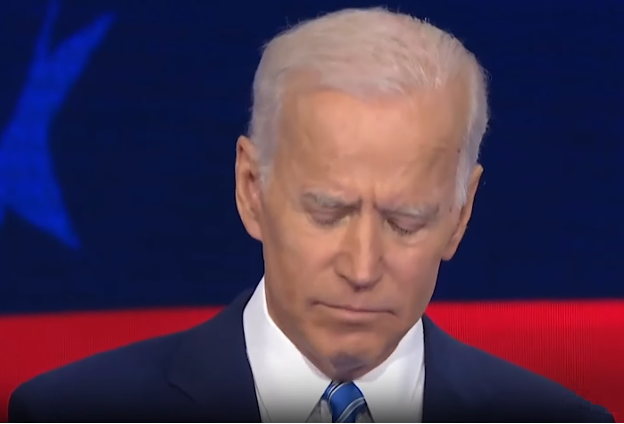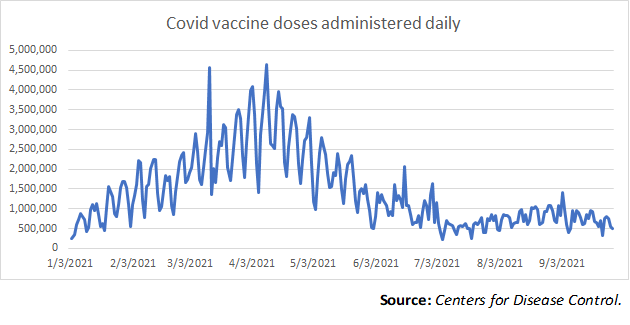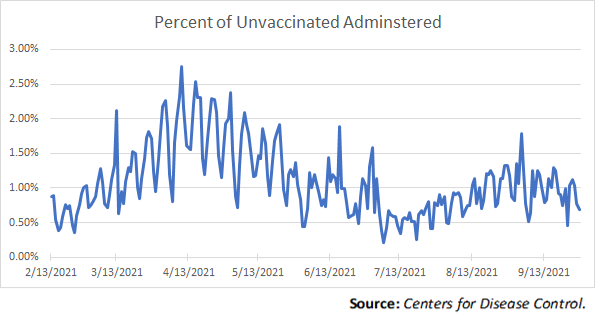At the current rate of vaccination — 712,000 a day since Biden’s announcement — it would take about 101 days to reach 100 percent of the eligible population receiving their shots assuming no drop off.

The rate of vaccinations has slowed down since President Joe Biden made his announcement on Sept. 9 that all employees at employers with 100 or more employees, plus health care workers, would have to get a Covid vaccine in order to keep their jobs.
In the 19 days since Biden’s mandate, 13.5 million Covid vaccine doses have been administered (712,000 average daily), compared with 15.9 million in the 19 days prior to the announcement (838,000 average daily), according to the latest data from the Centers for Disease Control. That’s a 15 percent drop in daily vaccinations.
To be fair, the rate of daily vaccinations peaked nationally on April 10 at 4.6 million. In other words, the drop off in vaccinations would have happened with or without the mandates simply because with 213.7 million single doses already administered out of 284 million Americans 12 years old and older eligible, there is a comparatively smaller pool of eligible citizens who have not yet been vaccinated.

But even when factored as a percent of the unvaccinated getting shots on a daily basis, the last 19 days showed 0.97 percent average increase daily versus 1.05 percent the 19 days before that.

That could be because Biden has not yet announced the deadline for private workers to get their shots by.
Currently, that total is about 71 million remain unvaccinated, or about 25 percent the eligible population. But to what degree and how quickly the current mandates will impact them — and will federal courts allow them to stand constitutionally?
Assuming the vaccination rate holds across the population regardless of work status, of the 71 million unvaccinated, about 25 million are not in the labor force and therefore not subjected to the mandates.
Another 11 million or so work at employers with less than 100 employees or for the government. Those are not being targeted either.
And then about 8.4 million are between the ages of 12 and 15, similarly ineligible to work and so not targeted.
Therefore about 47 million out of the 71 million unvaccinated eligible to receive the shot will not be targeted by the mandates. That leaves roughly 24 million who are subjected to the mandates, plus another 2.8 million federal employees subjected to a prior Biden executive order.
At the current rate of vaccination — 712,000 a day since Biden’s announcement — it would take about 101 days to reach 100 percent of the eligible population receiving their shots.
But Biden is only giving another 56 days to get the shot for federal workers who have until Nov. 22.
Meaning, if Nov. 22 were also applied to all workers at employers over 100 employees plus health care workers — the Department of Labor has yet to issue its new emergency standard so we don’t know what date private workers will have to get the shot by — at the current rate of 712,000 shots a day, another 39.1 million will get the vaccine, including 13 million who were mandated, leaving almost 32 million Americans unvaccinated, and 11 million losing their jobs.
If the date was pushed to Dec. 31 for all workers, at the current rate of 712,000 shots a day, 66.4 million would get their shots, including 21.9 million mandated, leaving 5 million unvaccinated and about 2 million Americans would still lose their jobs.
What will never be known is how many Americans would have received the shots anyway had there been no mandates.
The questions become 1) what date the Biden administration will choose as the deadline, 2) whether the rate of vaccination will increase as the deadline approaches, 3) if so, to what degree, and 4) if federal courts allow the mandates to stand.
How all that shakes out will determine how large the recession Biden is creating will be. For now, when the deadlines are announced and they are met — it is very hard to imagine a scenario where millions of Americans are not losing their jobs because of Biden’s mandates. Stay tuned.
Robert Romano is the Vice President of Public Policy at Americans for Limited Government.





